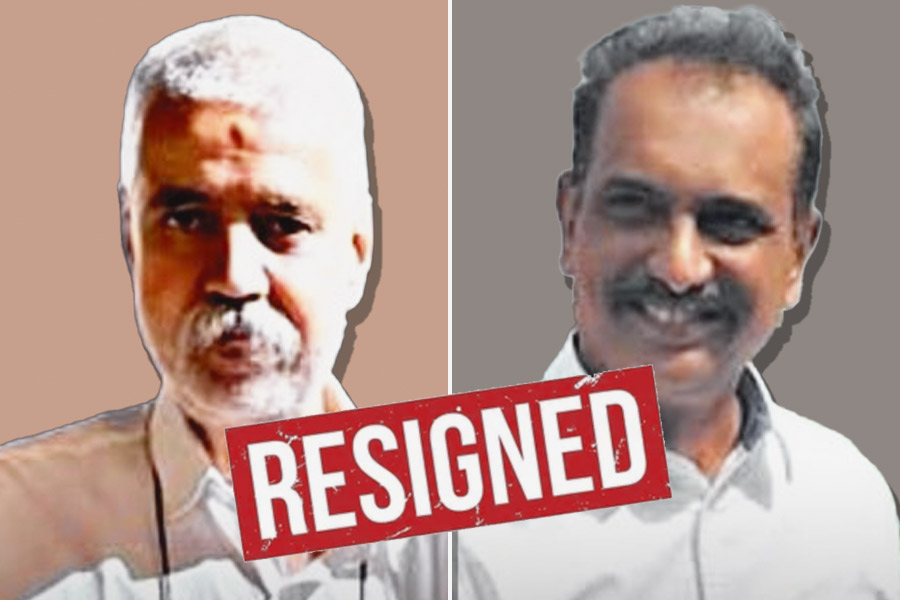 |
| Director Jahar Kanungo with his cast on the sets of Nisshabd in a village near HaldiaTrina Neelima Banerjee in Nisshabd |
A yellow green afternoon in a Bengal village. The smell of crushed lime leaves, of raw mangoes roasted. Leaping fishes creating ripples on water. Images sure to mesmerise you but yet director Jahar Kanungo insists that his directorial debut Nisshabd is all about sound. The sound of soundlessness. The English title of his film reads Reaching Silence.
An adviser to a fertiliser company, Kanungo surprised himself when Nisshabd won the Best Film Award at this year?s Osian?s Cinefan Asian Film Festival. ?I have always had a 9-to-5 job and was just interested in photography and travelling,? says the Delhi-based Bengali, who was in Calcutta last week looking for distributors and exhibitors for a commercial release. ?I also made five or six documentaries before this first feature of mine.?
Kanungo?s script about ?a man?s obsession with silence? was chosen for the prestigious Fonds Sud Cinema grant alongside Sudhir Mishra?s Hazaaron Khwaishein Aisi and Adoor Gopalakrishnan?s Shadow Kill. ?We all got to choose what we wanted to take out of the tie-up with Artcam in Paris,? explains Kanungo. ?Sudhir went for raw stock and other equipment. I went for a France-based cameraman (Dilip Verma) and sound recordist (Dominique Veillard), and also did the sound mixing in Paris.?
Back in India, Nisshabd found sponsors in ONGC, UTI and Ranbaxy, helping support the Rs 1.5 crore production. With the money in the kitty, Kanungo set about the casting. ?I didn?t go for stars because I knew there were no reference points to the characters in my film and I needed acting workshops and a lot more time with the people I chose,? he explains. ?So I went for the theatre people I have known over the years and got my friends and family members to come forward and help me with the production. We couldn?t pay specialised people.?
With 40 ?friends and family? members, Kanungo shot Nisshabd in just 42 days in Delhi and in a village in Haldia. ?Bengal was in my system although I have been away from the place for a long time,? smiles Kanungo, who studied in Vidyasagar College before relocating to Delhi for work. ?I couldn?t possibly make a film without Bengal in it.?
Spinning a tale around ?noise and noiselessness? wasn?t easy. Says Kanungo: ?It?s one of the ideas that I had and luckily unlike other ideas, here I found an ending to the idea. So in my film, here is this man who escapes to his village searching for silence and even the fragile peace that he discovers there is shattered because of his obsession with noiselessness.?
What is the one thing in the film that is finding favour with audiences across boundaries and bagging awards at every festival? ?It?s the way sound has been shown in the film ? as noise and also as rhythm,? Kanungo explains. ?Nisshabd explores concepts like why sound at all appeals to man and how a little sound can work as a bridge between people and places. I have even used sound to go into flashback, which is usually done through images in films.?
Seasoned theatre actors Kaushik Chakraborty and Trina Neelima Banerjee headed the cast that also included other familiar faces like Sudeshna Basu and Robishankar Kar. ?Kaushik is just superb,? says Kanungo. ?It is he who carries the entire film on his shoulders. Then there?s Trina, of course, who bagged the Best Actress award at the Osian?s Cinefan Festival. It was her freshness which everybody liked. Whether she was smiling or crying, every emotion came out so naturally.?
Once ready, Nisshabd embarked upon the festival tour, being picked for every fest that has anything to do with Asia. After a long time, an Indian film got selected in the competition section of the Pusan Film Festival in Korea. Says Kanungo: ?We had six screenings there ? three back-to-back shows in two parallel theatres ? and despite having just subtitles, I was so happy to see everybody reacting to the little, little emotions in the film.?
Kanungo may not get to see the reactions in all the festivals that Nisshabd makes it to. ?I have not given up my job and I do not intend to,? he says firmly. ?I can?t make a living out of film-making and would only do films when I am ready with some thought to share. So I am planning to skip some of the festivals that invite us and visit some of the others. It?s great to learn first-hand the reactions of foreigners to the film.?
But Kanungo wants the next major stop of his film to be a theatre for people to go and watch Nisshabd. ?I have spoken to quite a few people in Calcutta and I am looking at a commercial release sometime in January or February next year,? he reveals. ?Although I have received a lot of acclaim and appreciation from people everywhere, I am particularly keen to learn how Calcuttans respond to the movie.?
Even as Kanungo returns to his Delhi office, he is already churning a new tale in his head, a new idea which he can depict on celluloid.
?It is at a very premature stage but I am again looking at a foreign tie-up to produce the film. Can?t say the idea for sure but, yes, Bengal will again be a very important element of the project.?











